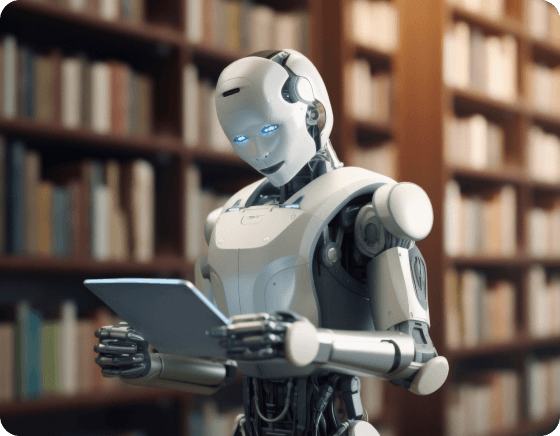29. October 2024
What is a AI Trends in Education: 10 Game-Changing Innovations for 2024?
AI in education is already transforming classrooms in a big way. According to a Forbes survey (2024), 60% of teachers are using AI tools to enhance their teaching. From adaptive learning systems to AI-driven tutoring, these technologies are changing how students learn and how educators teach. We’ll explore ten key AI trends in education that are shaping the future of learning and what they mean for both students and educators.
1. Personalized Learning with AI
The concept of personalized education is not new, but AI is making it more achievable than ever. AI allows teachers to tailor lesson plans to fit each student's learning style, pace, and ability level. By analyzing data from student assessments and interactions, AI systems can adjust content, recommend resources, and provide personalized feedback.
This level of customization ensures that no student gets left behind. Whether a student needs extra support or is excelling beyond the curriculum, AI-powered education solutions can meet them where they are.


2. Intelligent Tutoring Systems (ITS)
Intelligent Tutoring Systems (ITS), powered by AI and machine learning, are taking virtual tutoring to the next level. These systems act like personal tutors, guiding students through exercises, answering questions, and even identifying misconceptions. With generative AI and Large Language Models (LLMs), ITS can simulate real-time conversations with students, helping them understand complex topics in a more interactive way.
For example, students studying a math problem can receive step-by-step guidance from an AI tutor, just as they would from a human teacher. As these systems continue to evolve, we can expect them to provide increasingly nuanced explanations and adapt to student responses with greater accuracy.
3. Virtual Avatars for Student Interaction
Imagine a classroom where students interact with virtual avatars representing historical figures, scientists, or foreign language speakers. AI enables the creation of lifelike avatars that can simulate real-time dialogue, offering an engaging and immersive learning experience.
These virtual tutors can guide students through experiential learning activities such as historical reenactments, foreign language practice, or even virtual lab experiments. With AI language models and Natural Language Processing (NLP), these avatars can understand and respond to students, enhancing both learning and engagement.


4. AI for Progress Tracking
AI-powered tools can track students' learning patterns, identify strengths and weaknesses, and provide real-time reports to educators. This helps teachers intervene when necessary, offering additional resources or one-on-one time to struggling students.
By keeping track of progress tracking data, AI can predict a student's likelihood of success in a particular subject and offer tailored solutions to improve outcomes.
5. Emotion Recognition Technology
Emotion recognition is an emerging trend in education that could dramatically change the way educators approach classroom dynamics. Using facial recognition and data analysis, AI systems can detect a student’s emotional state - whether they're confused, engaged, or bored. This allows teachers to adjust their teaching style or content in real time to keep students engaged and on track.
For example, if a student appears frustrated, AI could suggest simpler explanations or pause a lesson for review. Conversely, it can push high-performing students to more advanced material to maintain their engagement.


6. AI-Powered Chatbots for Student Support
Imagine a chatbot that can answer all of your school-related questions 24/7. AI-powered chatbots are revolutionizing student support services in educational institutions. From answering questions about assignments to providing administrative help, these chatbots are making learning more accessible for students everywhere.
AI chatbots also ensure that students get timely responses to their questions, whether it’s about the next due date for an assignment or clarifying a topic discussed in class. This is especially useful in online and hybrid learning environments, where students may need assistance outside regular school hours.
7. Adaptive Learning Platforms
Adaptive learning platforms use AI for education to provide a tailored learning experience for each student. These platforms adjust the difficulty and content of lessons based on individual performance and learning speed. By continuously analyzing a student’s learning behavior, AI-powered platforms create a more efficient and personalized learning journey.
These systems are particularly useful in subjects like math, science, and language learning, where mastery of a concept is crucial before moving on to the next topic.


8. AI in Inclusive Education
AI is also playing a crucial role in inclusive education. By offering tools like voice-to-text, text-to-speech, and automatic translation, AI can help students with disabilities or language barriers access learning materials more easily. For example, AI-powered text compare tools can help students with dyslexia identify and correct spelling mistakes in their writing.
This technology ensures that every student, regardless of their abilities or background, can participate fully in the learning experience.
9. Smart Classrooms
The smart classroom of the future will likely be powered by a combination of AI, IoT (Internet of Things), and smart devices. AI in schools enables classrooms to become more interactive and efficient. For example, smart boards and AI-driven educational software can adapt to the needs of the classroom in real-time, optimizing the learning environment based on student performance and teacher preferences.
Teachers can also use AI to manage administrative tasks like attendance tracking, grading, and lesson planning, freeing them up to focus on what really matters - teaching.


10. AI-Generated Educational Content
Generative AI can create lesson plans, quizzes, and even write essays, reducing the workload on teachers and providing fresh, up-to-date material for students.
Silk Data has developed some AI-powered tools that compare and summarize texts to make life easier for educational institutions. These tools help teachers quickly compare student work, track progress, and give fast, accurate feedback. Plus, they can summarize tricky materials so students can understand the key points faster. It's all about making classrooms more efficient and learning a lot smoother!
Automatic Knowledge Structuring
Automatic knowledge structuring in education is an AI-driven approach to organizing information more effectively for both students and teachers. Instead of manually sorting through vast amounts of data, AI can automatically arrange content into logical patterns, making it easier to navigate complex subjects. This technology helps break down large topics into smaller, interconnected concepts, which can be visualized using tools like mind maps and knowledge graphs.
Mind Maps
Mind maps in AI education are a powerful tool for visually organizing information, turning complex subjects into easy-to-digest, interconnected pieces. With AI, these mind maps can be generated automatically and tailored to each student’s progress, making learning more dynamic and engaging. As students dive deeper into topics, the mind maps evolve with them, creating a personalized and interactive way to explore and understand even the trickiest concepts.
Knowledge Graphs
Knowledge graphs go beyond simple mapping by connecting the dots between different concepts, making learning much more insightful. In AI-powered education, these graphs track what a student knows, pinpoint areas they’re struggling with, and suggest relevant materials to fill those gaps. By revealing how various topics are linked, knowledge graphs offer a personalized learning experience, making it easier for students to understand and apply complex ideas in a way that feels natural and engaging.
The Benefits and Drawbacks of AI in Education
While AI in education brings a host of advantages, it also comes with its own set of challenges. Here’s a closer look at both.
Benefits of AI in Education.
Personalization
Tailored learning experiences that meet the needs of every student.
Efficiency
Automation of administrative tasks such as grading and progress tracking.
Accessibility
Tools like text-to-speech and emotion recognition help make learning more inclusive.
Engagement
Interactive learning experiences like virtual tutors and AI-generated content keep students motivated.
Support
AI-powered chatbots offer round-the-clock assistance for students.
Drawbacks of AI in Education.
Cost
Implementing AI tools can be expensive, making them inaccessible to underfunded schools.
Data Privacy
The use of student data for AI analysis raises concerns about privacy and security.
Teacher Dependence
Over-reliance on AI tools could reduce the need for human educators, affecting teaching jobs.
Bias and lack of interpretability
Bias in AI data can reinforce existing inequalities - leading to unfair outcomes in areas like grading and admissions, which even may spark protests. The lack of interpretability makes AI decisions difficult to understand or challenge, increasing concerns about transparency and fairness.
Technical Challenges
Not all schools have the infrastructure to support AI technologies, leading to unequal access

The Future of AI in Education
As we look to the future, AI and education are set to become even more connected, making classrooms smarter, more personalized, and inclusive. The AI impact on education will keep evolving, with tools like AI-powered chatbots, adaptive learning platforms, and emotion recognition technologies changing the game for both teachers and students. But with all these advancements, we can't ignore the challenges like data privacy and making sure every student has access to these tools, no matter their background.
By embracing these trends, educators can create a more dynamic, responsive, and supportive learning environment than ever before.
Frequently Asked Questions
AI can sometimes create more problems than solutions in education if not used wisely. One issue is the loss of human interaction, which is a big part of the learning process. With AI-based learning platforms, students may spend less time engaging with teachers or classmates, missing out on the social and collaborative aspects of education. A big worry with AI is that it might push students toward "surface learning"s, where they’re just looking for quick answers instead of really understanding the material. On top of that, AI algorithms aren’t always fair - if they’re trained on biased data, they could give unfair feedback or grades.
When students use AI tools for their assignments, it’s important they follow some basic guidelines. First off, they should never let AI fully take over the work. AI can help with things like generating ideas, checking grammar, or researching, but it shouldn’t be the one writing their essays or solving problems. Students should always understand the material and be able to explain their work. Another important restriction is to avoid using AI during exams unless it's explicitly allowed, as it can lead to unfair advantages. Plagiarism is also a big concern, and students should be aware that schools may use AI plagiarism detection tools to spot whether their work has been copied or generated by a machine. They should also stay informed about their institution’s specific rules around AI use, as violating these could lead to academic penalties.
AI is becoming a handy tool for teachers in a bunch of practical ways. One popular use is AI-powered grading systems, which can handle a wide range of assignments much faster than a human. This saves teachers time, letting them focus more on classroom interactions. AI also helps teachers identify students’ strengths and weaknesses by analyzing data from quizzes and assignments, which means they can offer more personalized help. In addition, AI-powered lesson planning tools can generate resources, suggest activities, and even tailor lessons to meet the needs of different students. Teachers also use AI to monitor student engagement, spotting when someone is falling behind or needs more support. Despite all these benefits, teachers still play a key role in guiding and mentoring students, ensuring that AI is a supplement to - not a replacement for - traditional teaching methods.

